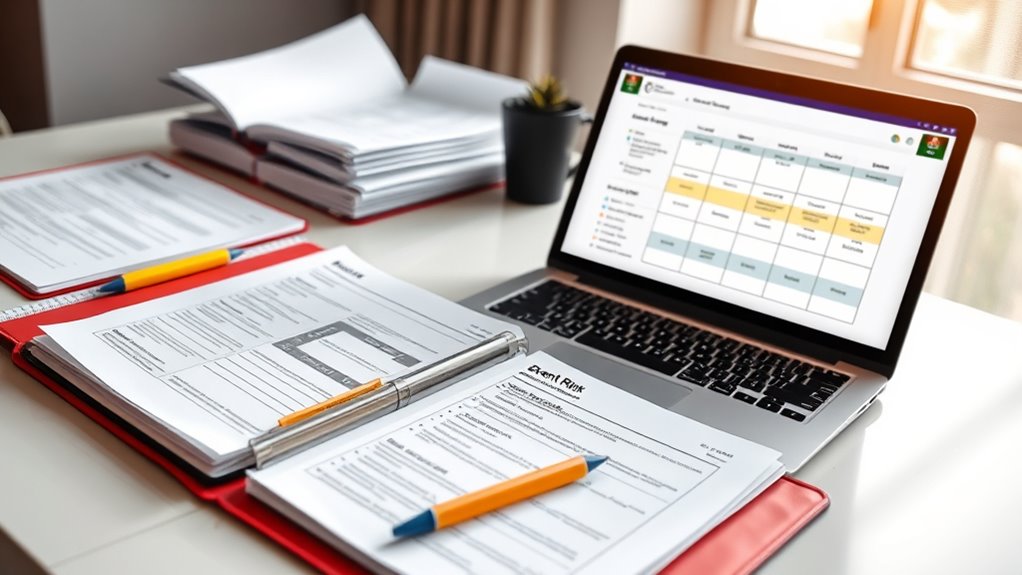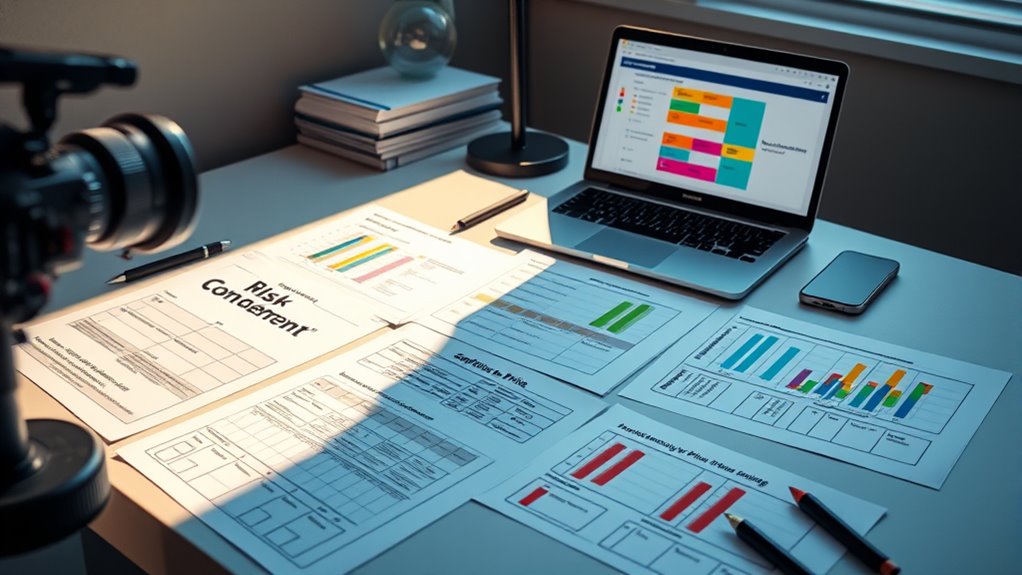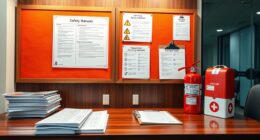Your event risk management documents are essential tools to identify, assess, and plan for potential hazards before they happen. By creating clear assessments and detailed contingency plans, you can mitigate risks like weather issues, equipment failures, or crowd control problems. These documents should be regularly reviewed and practiced to guarantee everyone knows their roles and response procedures. Continuing will reveal how to develop all-encompassing, adaptable plans that keep your event safe and successful.
Key Takeaways
- Conduct thorough hazard assessments to identify potential risks and prioritize contingency planning accordingly.
- Develop clear, step-by-step emergency procedures tailored to specific hazards like weather or medical incidents.
- Maintain detailed insurance documentation covering liabilities, damages, and cancellations for financial protection.
- Create flexible contingency plans that address high-severity risks and include evacuation routes and safe zones.
- Regularly review, update, and rehearse risk management documents to ensure preparedness and effective response.

Effective event risk management documents are essential tools that help you identify, assess, and mitigate potential hazards before they impact your event. When you prepare these documents thoroughly, you create a clear roadmap for handling unexpected situations, ensuring the safety of attendees, staff, and vendors. One of the key elements to include is all-encompassing insurance coverage. By documenting your insurance policies, you confirm that you’re financially protected against liabilities, damages, or cancellations. This not only provides peace of mind but also ensures that you can respond swiftly if an incident occurs. Insurance coverage should be tailored to the specific risks of your event, whether it involves property damage, medical emergencies, or weather-related issues.
Thorough insurance documentation ensures financial protection and swift response for your event emergencies.
Alongside insurance, establishing well-defined emergency procedures is critical. Your risk management documents should delineate step-by-step actions for various emergencies, such as medical incidents, fire outbreaks, or natural disasters. Clear procedures help staff respond efficiently, minimize chaos, and prevent escalation. For example, your plan might specify who to contact first, where to direct injured attendees, or how to evacuate the venue safely. These procedures should be communicated effectively to everyone involved and regularly rehearsed through drills or training sessions. Having these protocols in place means that when an emergency occurs, actions are swift, organized, and effective, reducing potential harm and confusion.
Creating thorough assessments of potential hazards is also fundamental. You need to evaluate the likelihood and impact of risks like overcrowding, equipment failure, or adverse weather conditions. These assessments allow you to prioritize your planning efforts, focusing more on high-risk areas. For each identified hazard, you should develop contingency plans that specify how to respond if the risk materializes. For instance, if bad weather threatens your outdoor event, your plan might include relocating activities indoors or postponing certain sessions. These contingency plans should be flexible yet detailed enough to guide your team during moments of stress or uncertainty.
In addition, reviewing anime movies related to your event theme can help inspire creative safety protocols and engaging attendee experiences. These films often showcase diverse themes and storytelling techniques that can be adapted to event planning scenarios. These assessments and contingency plans should be flexible yet detailed enough to guide your team during moments of stress or uncertainty.
In the end, your event risk management documents serve as living tools—documents you review, update, and practice regularly. They ensure that every aspect of your event’s safety is accounted for, from insurance coverage to emergency procedures and hazard assessments. When you’re prepared with solid plans in place, you can handle surprises confidently and deliver a successful, safe event for all involved.
Frequently Asked Questions
How Often Should Risk Assessments Be Reviewed and Updated?
You should review and update your risk assessment frequency regularly, ideally before every event or at least annually. Your plan review schedule should be flexible enough to accommodate changes in event circumstances, new hazards, or feedback from previous assessments. By keeping your risk assessments current, you guarantee your contingency plans remain effective, helping you respond swiftly and confidently to potential issues. Regular reviews are essential for maintaining safety and compliance.
Who Is Responsible for Approving Contingency Plans?
You’re the key to guaranteeing smooth planning, so when it comes to contingency approval, you hold the responsibility for plan authorization. Your role is to review and approve contingency plans, making sure they’re aligned with safety standards and event needs. By actively overseeing this process, you ensure that all plans are properly authorized, minimizing risks and fostering confidence in your team’s preparedness. Your proactive involvement is essential for effective risk management.
What Tools Are Recommended for Effective Risk Documentation?
You should use tools like risk assessment matrices and digital documentation platforms to guarantee effective risk documentation for contingency planning. These tools help you identify potential hazards, evaluate risks, and develop clear mitigation strategies. By maintaining thorough records, you can easily update your contingency plans and ensure everyone involved understands their roles. Regularly reviewing and updating these tools keeps your risk assessment accurate and your contingency planning proactive, minimizing event risks.
How Do Risk Management Documents Integrate With Emergency Response Plans?
You integrate risk management documents with emergency response plans by guaranteeing clear risk communication and involving key stakeholders early. This way, everyone understands potential hazards and their roles during an incident. You update the plans regularly, reflecting new risks and lessons learned. Engaging stakeholders fosters collaboration, making response efforts more coordinated and effective. Ultimately, this integration strengthens your preparedness and ensures a swift, organized response when emergencies occur.
What Training Is Necessary for Staff Regarding Risk Management Procedures?
You need to guarantee staff awareness through thorough training modules that cover risk management procedures. While some might think training is time-consuming, it actually prepares your team to act swiftly and confidently during emergencies. Focus on practical, scenario-based modules that teach staff how to identify risks, follow protocols, and execute contingency plans. Regular refreshers reinforce their knowledge, making your event safer and more resilient against potential hazards.
Conclusion
As you finalize your event risk management documents, remember that thorough assessments and contingency plans aren’t just formalities—they’re your safety net. But what unforeseen challenge might strike next? Will your plans hold up under pressure? Stay vigilant, continuously review, and adapt your strategies. Because when the unexpected happens, your preparedness will be the difference between chaos and control. Are you truly ready to face what’s around the corner? The next move could define your event’s success—or its failure.









